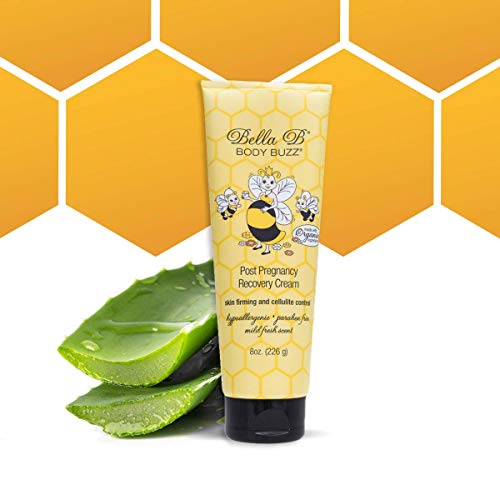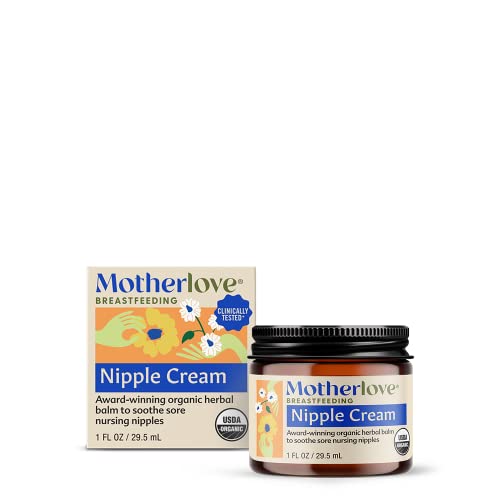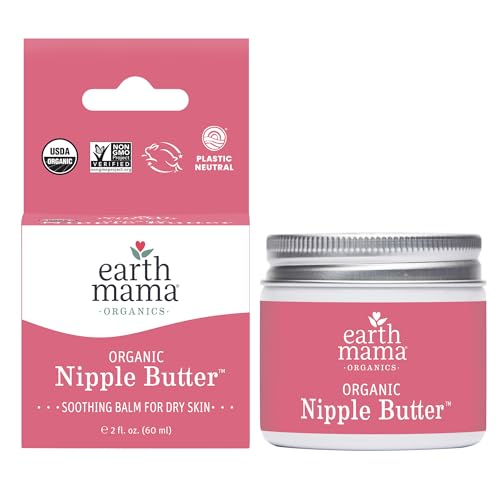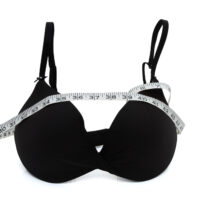Breastfeeding is the ideal way to nourish and bond with your baby. However, the joys of breastfeeding often come along with the discomforts of sore, dry, and sometimes even cracked and bleeding nipples. Nipple creams and nipple balms were created to protect your nipples from skin breakdown by decreasing friction and also provide a protective barrier to soothe existing skin damage.
After hours of research and gathering input from breastfeeding mothers, I have compiled a list of the best nipple cream choices for 2021
Best Nipple Creams for Breastfeeding
Medela Tender Care Lanolin Cream is 100% safe for baby so there is no need to wash it off before nursing your little one, where the Palmers Cocoa Butter Nursing Cream is not organic and should be removed from your nipple before feeding your baby.
Lansinoh HPA Lanolin Nipple Cream

Lansinoh HPA Lanolin Cream is the #1 recommended nipple cream by lactation consultants and doctors in the US. This cream is hypoallergenic, 100% natural, and contains no additives, preservatives, or parabens. Lansinoh’s proprietary filtration process gently removes impurities, detergents, and trace pesticides to yield pure, 100% safe lanolin.
Despite being one of the best breastfeeding creams on the market, some mothers reported that Lansinoh had a thick, sticky texture, and was sometimes hard to squeeze out of the tube. A few mothers also claimed that although the application is easy, it left a greasy residue on their clothing which did not wash out.
This product goes beyond nipples, it can be used for dry lips, cuticles, and heels. Some even reported using it as a brow balm!
Bella B Nipple Nurture Butter
Free of petroleum, lanolin, and parabens, Bella B Nipple Nurture Butter contains only plant-based ingredients like olive oil and shea butter, that are completely harmless to both baby and mom. This means it can be used before and after breastfeeding and that there is no need to wash it off your breasts prior to nursing.
Mamas with extremely cracked nipples loved this natural butter because it was thick, melted quickly, and stayed in place. Due to this thick consistency, most moms suggested using this butter in conjunction with nursing pads because it left greasy-looking stains on their clothing.
This nipple butter is also useful for and effective on both diaper and drool rash, and the many other common baby- skin irritations.
Palmer’s Cocoa Butter Nursing Cream
Palmer’s Cocoa Butter Nursing Cream is a smooth and easy to apply combination of pure cocoa butter and Pro Vitamin B5. The soothing emollient base helps relieve the sore, dry nipples that are associated with breastfeeding.
Nursing mothers say this less expensive option has a lighter texture and smells better than most others. Which may be something to consider if you are sensitive to smells or low on cash.
On the other hand, this nursing cream is not certified as organic and cleaning it from your breasts before nursing is recommended. Also, mothers reported a tendency to stain clothing.
Medela Tender Care Lanolin
Medela’s nipple cream is no exception to their excellent reputation of “all things breastfeeding”. Medela Purelan Lanolin offers soothing relief and provides protection to the sorest of nipples.
Purelan is made from organic ingredients which include Lanolin, Caprylic/Capric Triglycerides, and Oat Beta Glucan.
Medela nipple lanolin is 100% safe for ingestion and there is no need to wash it off before breastfeeding. Mothers who use this nipple cream love the feel of the smooth, silky texture. The Tender Care version of this product is in limited supply but is less thick and smoother than Purelan but also currently more expensive.
This product is also great for chapped lips!

Best Organic Nipple Creams for Breastfeeding
Mom’s love Motherlove Nipple Cream for the jelly-like texture for their sore, cracked nipples, however, while mom’s like the Organic Nipple Butter Breastfeeding Cream by Earth Mama and its healing effects, they complain about the grainy texture of this cream.
Motherlove Nipple Cream
Motherlove Nipple Cream is a 100% USDA certified organic and cruelty-free herbal salve that provides soothing relief to sore and cracked nursing nipples. It is made only of extra virgin olive oil, shea butter, marshmallow root, beeswax and calendula flower.
These ingredients are safe for ingestion and completely non-toxic, so it can be used before and after breastfeeding and there is no need to wash it off your breasts prior to nursing. Moms raved about the texture of this cream, reporting that it is easy to apply and they loved the jelly-like consistency, as opposed to the stiff, pasty texture of other products.
This cream can also double as an ointment for cuts, scrapes, and diaper rashes, or as a lip balm. And, the company even offers a money back guarantee if you are not satisfied with your purchase.
Bamboobies Boob-Ease Organic Nipple Balm
Bamboobies Boob-Ease Organic Nipple Balm is made of 100% USDA certified organic ingredients which help keep nipples feeling soft, supple, and healthy. This helps prevent cracking and the pain associated. Because it contains no lanolin or vitamin E, it is safe for ingestion and harmless to your baby. There is no need to wash it off your breasts prior to nursing and moms loved this nipple balm for the thin consistency and found it easy to rub into the skin before and after breastfeeding.
The Honest Co. Organic Nipple Balm
Made with only certified organic ingredients, Honest Organic Nipple Balm reconditions nipples that have become irritated, chapped and sensitive from nursing.
This balm can be used before and after nursing, as it is safe for ingestion and free of mineral oil, parabens, synthetic fragrances, and lanolin.
It is made of castor seed oil, shea butter, beeswax, and Tamanu oil.
Moms love Honest Nipple Balm for the thin, silky texture, but found this consistency to be a bit messy during application from the jar.
Mothers who were exclusively pumping raved about this nipple balm because it doubles as a pumping lubricant.
Earth Mama Organic Nipple Butter
Earth Mama Organic Nipple Butter is the first lanolin free, Non-GMO Project Verified nipple cream. It is made from 100% organic ingredients like shea butter and olive oil and it is both non-toxic and safe for ingestion. You do not have to worry about washing it off your nipples before nursing and it can also be used before breastfeeding.

Moms love this butter for its quick ability to heal even the sorest nipples. However, some did not care for its texture. This nipple butter has a grainy consistency and is hard to rub in completely.
Alternatively, this thick butter can also be used for chapped lips and cheeks or dry heels and rough elbows. It also works excellent as a breast pump lubricant. Find our list of the top rated breast pumps in this article.
If Earth Mama sounds familiar, it is because Earth Mama Organics was formerly known as Earth Mama Angel Baby.
Experienced Mommy’s Video Review
Here is a video we made reviewing earth mamma’s nipple butter.
Era Organics Mommy Balm
If you have sensitive skin, then Era Organics Mommy Balm is the perfect nipple balm for you! It has an organic, non-GMO, plant base, and the totally natural formula is harmless to mom and baby. There are no harsh chemicals or allergenic ingredients such as lanolin to set off sensitive skin. Chamomile, calendula, beeswax, sunflower, and cocoa butter help to calm irritated skin as they heal, repair, and protect. It is great for chaffed or cracked nipples.
The solid texture melts easily in your hands and absorbs really well, while still offering protection against further skin breakdown.
Safe for ingestion and free from the toxic and scary ingredients like alcohol, petrolatum, mineral oil, sulfates, parabens, perfumes, or dyes. This is also a fabulous product for dry elbows, heels, and any other skin that needs some healing!
Milkies Nipple Nurture Balm
Milkies Nipple Nurture Balm restores cracked and dried skin and soothes tender nipples with shea butter. It is completely organic and free of lanolin, harsh chemicals, and additives. There is no need to wash this balm from your breasts prior to nursing and it can be used for breastfeeding. Moms loved this product for the healing power, but noted it a messy consistency and an odd smell.
This nipple balm is made in the USA and it can also be used for dry or irritated skin and chapped lips.
The Best Nipple Creams Compared
The table below compares only the recommended products on this page. A low or high Price means it is low or high compared to the other products listed. The Popularity Score reflects how often readers click on and buy the product. The Quality Score is our assessment of the overall performance and satisfaction with the product compared to others in the table.
| Era Organics Mommy Balm | 9.3 | 9.0 | 16.70 |
| The Honest Co. Organic Nipple Balm | 8.5 | 9.2 | 14.99 |
| Motherlove Nipple Cream | 9.9 | 9.4 | 12.99 |
| Earth Mama Organic Nipple Butter | 9.9 | 9.4 | 12.99 |
| Bella B Nipple Nurture Butter | 4.0 | 9.0 | 11.99 |
| Milkies Nipple Nurture Balm | 8.4 | 8.8 | 11.95 |
| Bamboobies Boob-Ease Organic Nipple Balm | 9.7 | 9.4 | 10.00 |
| Palmer's Cocoa Butter Nursing Cream | 3.9 | 9.4 | 9.00 |
| Medela Tender Care Lanolin | 9.9 | - | 7.98 |
Guide to Selecting the Best Nipple Cream
According to NHS, sore and tender nipples are the main reason that women give up on breastfeeding, but with the right help and support, this problem can often be easily sorted out. Sore nipples due to poor positioning and latch very often occur about three to seven days into breastfeeding. However, dry and cracked nipples can occur at any time, even if you are doing everything correctly. Using a nipple cream to prevent skin breakdown will set you up for success.
If you find that your nipples hurt at every feeding and you do not get relief from the creams on this list, then you should consult a breastfeeding specialist. They can help determine if the underlying issue may be due to poor positioning or possibly an infection such as yeast. You can use a nipple shield temporarily to alleviate pain and protect your skin from further damage, but nipple shields have been shown to reduce milk transfer and can lead to bigger issues like a plugged duct or mastitis. A nipple shield is a great tool in the right situation. However, if you are considering using one for nipple pain then it is definitely time to seek consultation.
You are breastfeeding because you are trying to provide the best for your baby and besides being painful, when your sore nipples can be very discouraging. Choosing a quality nipple cream or breastfeeding butter can help prevent and alleviate some of these discomforts so you can get the job done.
Below are three things to keep in mind when choosing a nipple cream.
Ingredients and Safety
- Make certain that the ingredients in your chosen nipple cream are safe for both you and your baby. It is best to choose a natural product that is listed as organic or all-natural.
Texture
- The thicker textured creams are best for severely cracked or bloody nipples because they provide a protective barrier along with moisture. The thinner creams are better for mild to moderate discomfort, as well as for those who do not wish to use nursing pads.
Portability
- Available in both jars and tubes, choose the option that works best with your lifestyle.
Nipple Shields
Nipple shields can be a lifesaver for sore nipples. I had to try several to find the right shape and thickness.

FAQ’s about Nipple Creams
Lately, lanolin has received a lot of negative attention. Is it safe for my baby?
For generations mothers have used lanolin cream for nipple care. However, recent research has found that lanolin can contain a heavy load of pesticides, so consider the source. Lanolin is derived from sheep’s wool. The lanolin options listed above have been refined to remove all unsafe and allergenic components.
Some women may be allergic to lanolin and not be aware of it. Check with a doctor if you are using a lanolin product and experience any unexpected symptoms such as a rash or hives.
What should I do if I run out of nipple cream or forget it when I leave the house?
If you’re in a pinch, breast milk works wonders for nipple care and it is an all- natural, 100% organic, non-GMO option. In fact, if you get into the habit of expressing a few drops of breast milk to rub on your nipples after each feeding, you may not need a nipple cream at all! Just rub on a few drops and let air dry. You can also use coconut oil for nipples, choose an organic option and wait for it to absorb before breastfeeding.
Do I have to remove the nipple cream before breastfeeding?
Most of the options listed above are 100% organic and safe for ingestion, meaning they can be used for breastfeeding and that there is no need to wash them off prior to breastfeeding, but please check the manufacturer’s instructions on your nipple cream for this information.
Are there any home remedies for dry, cracked nipples that I should avoid?
Healthline cautions against using wet tea bags for cracked or dry nipples. While this is a popular remedy in many locations around the world, the tannic acid from the tea can have an astringent effect on the skin which could make your problem worse. If the moist warmth is appealing, they recommend that you stick to a plain water compress.















